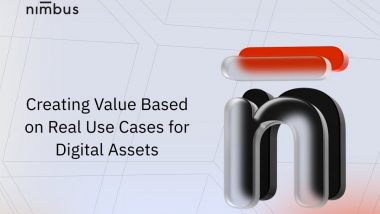The existing financial system has a lot to offer. However, it does not offer it to everyone, and at times, its efficiency leaves a lot to desire. But good news is, there is a bold alternative called DeFi (short for Decentralized Finance) which offers solutions to customers' pain points.
With DeFi, people around the world could stop feeling financially left out. They could stop bearing risks of losing their hard-earned funds due to financial institutions’ risk appetite, errors, and frauds. They could forget the centralization problems that make important decisions - and outcomes of such - one-sided. How? Find the answer below.
What is Decentralized Finance in the first place?
DeFi aims to provide alternatives for many traditional financial products and services, such as trading, loans, investment opportunities, while replacing their shortcomings and opening up the system for everyone.
It also creates infrastructure for crypto assets to be put to use rather than lie in users’ wallets. But the killer feature of DeFi is how it reinvents the underlying mechanisms of financial solutions and increases their efficiency through decentralization and cutting-edge technology. Here are some of it highlights:
- Risk and Upside Optimization through Decentralization and Automation. In DeFi, users have complete control and information about their own assets. This means, their funds cannot be invested in risky initiatives without them knowing. Their funds cannot get locked because the central party or the government decides so. Instead, users see all the required data about the financial products transparently on blockchain and make the best of decisions on how to use their funds themselves.
- Numerous Ways For Earning Profit and Putting Crypto to Use. DeFi also offers tons of opportunities to receive profits while still holding on to your crypto! This can be done without the need to meet rigorous requirements, like in traditional finance, so even the 1.7 billion of unbanked are welcome.
- Become shareholders rather than passive users with DAOs. Many DeFi projects launch DAOs (blockchain-based Decentralized Autonomous Organizations) which enable users to become a sort of shareholders and vote on how these DeFi solutions function and evolve, as well as get the revenue made with those solutions.
All in all, DeFi offers users more freedom to participate in the solutions they need at the conditions they choose and in a decentralized manner, with no hidden risks and intermediary fees. At least that’s what DeFi claims to offer… But is that really how it works?
Why Haven’t All of us Switched to DeFi Yet?
Considerably, it is a new concept. It will need to better adapt to customer needs and resolve a few things on its way to maturity:
- Few DeFi projects offer realistic revenue generation models for users.
Many projects out there offer users to make money out of thin air, e.g. game theory. Meaning you put in money and you withdraw more, without understanding what’s causing the sum to appreciate while it lies in the pool. Such revenue generation models could not be sustainable in the long run and it’s no surprise that it scares many users off.
- DeFi still lacks holistic, user-friendly ecosystems While one bank can offer you an entire pack of solutions to deal with your money and multiply it in many ways, same offers in DeFi are not so common yet. So users have to switch between different solutions and pay repetitive fees, spend time on research and registration, and bear the risks of leaving sensitive information on multiple platforms.
- Few Defi projects are fully audited and compliant, limiting their growth Since all financial products in DeFi are based on smart contracts that automatically execute transactions rather than company’s employees, you want to be sure they do it correctly. You also want to be sure that what the DeFi project does is legally compliant and no one will come haunting the team with all users fleeing and crashing the system.
...But eventually, a few bad apples will certainly not be what comprises the bunch. There are some good DeFi solutions taking off these days which address these shortcomings. Take Nimbus, an established Fintech company that now enters DeFi and aims to bring it down to earth and make it more friendly and efficient for common users.
Nimbus as a promising next step for DeFi adoption
Nimbus is an established Fintech company with a reputable team and a year-long track-record of delivering blockchain-based financial solutions to 50,000 users. In the coming days, it is launching a new DeFi ecosystem which could well stand at the forefront of DeFi for the years to come. Why? Because Nimbus combines all the best practices of both traditional and decentralized finance and addresses key DeFi user pain points in a holistic way. Managed by a seasoned team with highly relevant backgrounds.
Meet Nimbus: a DeFi ecosystem that offers 10 earning strategies for users based on real-world use cases - from P2P loans to IPOs and crowdfunding
In the coming days, Nimbus launches an ecosystem of four dApps and three tokens all managed by DAO for maximum user benefits. But what’s so special about it?
First of all, with Nimbus, users can forget about the far-fetched reward generation models that only a few people can trust or even understand.
Beneath the DeFi surface, each Nimbus dApp has a clear process of revenue generation behind it. Most of its dApps are attached to traditional financial tools and products that proved their effectiveness over decades. With Nimbus, those products will not only become available for crypto for the first time, but also their risks will get mitigated thanks to the DeFi mechanisms.
Once fully launched, the Nimbus Ecosystem will consist of four dApps. Here are the two most promising ones for the strater:
- With Nimbus IPO hub dApp, users with any crypto sums will have an unprecedented ability to participate in IPOs via liquidity pools.
The IPOs will be carefully studied and later voted on by the Nimbus DAO participants. All IPO relevant analytics will be found in one place for users to make their own decisions. All users will have to do is pick the crypto amount they want to put into IPOs and start earning their percentage. No extra brokerage fees, no extra registrations - pure efficiency.
- Nimbus Crowdfunding dApp will be a unique decentralized tool that enables anyone with crypto to participate in startup financing in a fully compliant, regulated way.
Users all over the globe will finally have access to convertible notes and startup equity, no matter their disposable sum or background. Thanks to liquidity pool mechanics, the risks and profits of such crowdfunding participation will be optimized. And since the funds will be distributed to startups automatically upon certain conditions, the risk of startup financing going wrong is also mitigated.
Nimbus will also launch 2 other dApps. The Crypto Arbitrage-Trading dApp, the centralized version of which has already been used by 50,000 users, and the P2P Lending dApp, which provides more flexibility and more risk management opportunities for users than many lending dApps out there.
But what’s even more important is that all these dApps will be placed within one ecosystem with just one token, NUS, providing access to all of them.
In 2020-2021, Nimbus users will enjoy 10 pools and products with different earning strategies all in one spot accessible through the NUS token that will be launched in December 2020.
But in the long run, Nimbus aims to add even more proprietary and third-party dApps and become a one-stop-shop that bridges digital assets to investment products for global users. Is that even possible? With the FINRA broker-dealer license, NFA, and SEC licenses that Nimbus aims to receive, it is. With them, Nimbus will be able to provide additional asset-classes and investment products, such as Pre-IPO Secondary Markets Share Participation - something no common person has access to today.
However using dApps is not the only opportunity for users to participate in Nimbus.
In order to make sure users have true control of the Nimbus Platform and enjoy extra abilities for revenue generation, Nimbus launches Nimbus DAO and a governance token, GNUS.
With GNUS, anyone can have the ability to participate in the direction of Nimbus Platform and receive its revenue shares. Notably, only 10% of governance tokens will be left to the Nimbus Organization, enabling true control decentralization.
But can Nimbus actually deliver all of this?
Nimbus has been around for a year now and the number of 50,000 users it accumulated speaks for itself.
Nimbus international team consists of renowned professionals with a great reputation, including ex top-managers of the biggest international corporations of today, such as Huawei. They cover all the required areas of expertise to be successful in the launch, including Cryptocurrency, Blockchain, DeFi, AI/ML, Finance, and Cyber Security.
The company also has pending audits from top smart contract audit firms such as Zokyo and agreements liquidity providers as well as the EU crowdfunding license underway.
But what’s more important, launching a DeFi Ecosystem for Nimbus is not a way to follow the hype or receive quick gains for the team. It is a way to fulfill Nimbus’ mission in the most effective manner and the team keeps its standards high just as before.
But the best news is that the Nimbus DeFi ecosystem is going to go live in December 2020 and anyone can participate!
Right now, Nimbus is finalizing its DeFi functionality development and audit and getting ready for the launch slated for December 2020.
Within the launch, Nimbus shall list the first of its three tokens, NUS token, at Uniswap. This token will be required in order to receive the access to any other functionality the Platform has in store - be it two other tokens or the participation in the four dApps to be launched in December 2020 or later in 2021.
These days it’s your last chance to hop on this project and be the first to benefit from its launch, along with over 50,000 other users who can’t wait for the launch!
(The above story first appeared on LatestLY on Dec 19, 2020 09:03 PM IST. For more news and updates on politics, world, sports, entertainment and lifestyle, log on to our website latestly.com).













 Quickly
Quickly











